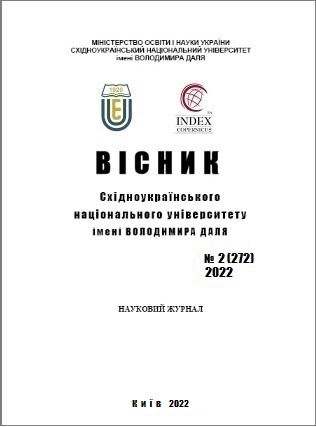Formation and implementation of the innovative marketing policy of the enterprise
DOI:
https://doi.org/10.33216/1998-7927-2022-272-2-126-135Keywords:
local budgets, united territorial community, financial decentralization, local budget revenues, taxes of local budgetsAbstract
The article focuses on the fact that marketing in its essential content is a theoretical concept that contributes to the adaptation of production entities to work in a market economy. Marketing is the activity of companies and organizations in the interests of their consumers. Marketing involves meeting the needs of the client with the benefit of the enterprise (firm). It is emphasized that the phased formation of a marketing policy involves: the implementation of analytical diagnostics of the enterprise and strategic foresight (forecasting) of its development; development of a marketing mix; ensuring effective organization and effective management of marketing; formation of an economically justified budget for marketing, control and evaluation of marketing activities, which is a platform for making managerial decisions. It is shown that in order to improve the efficiency the enterprises should introduce innovative marketing. Marketing innovation is the introduction of a new way of marketing that involves significant changes in product design or packaging, product placement, product promotion, or pricing. It is emphasized that in order to effectively implement an innovative marketing policy the enterprises need to implement a marketing strategy and conduct marketing research on the use of the latest methodological techniques: survey, observation, expert assessments and focus groups. It is noted that the basis of the innovative marketing policy of any enterprise is the pricing strategy. Choosing the right pricing strategy is the pinnacle of an enterprise's development strategy. It is noted that there are two opposite pricing strategies for setting the price of a new product: the pricing policy of "skimming the cream": setting a deliberately high price for a new product, which is necessary to obtain excess profits, which in a short time pays off the investments spent on development, production and withdrawal product to the market, and the pricing strategy of "market penetration", which consists in setting a deliberately low price for a new product. It is marked that along with the general (traditional) pricing strategies for a new product and for a product that has been on the market for a long time, firms should consider innovative pricing strategies, namely: premium pricing, in which sellers set a high price throughout the entire life cycle product. Attention is focused on the fact that an important way to improve the innovative marketing policy of an enterprise is to optimize the costs of marketing and advertising. To achieve this goal, it is necessary to introduce a system for quickly obtaining information about the effectiveness of both individual marketing activities and marketing activities as a whole. The main stages of evaluating the work of marketers in the implementation of an innovative marketing policy of an enterprise: setting goals, evaluating the results and preparing a program of corrective measures that will help eliminate the identified negative aspects of the work of the marketing service.
References
1. Кардаш В.Я. Маркетингова товарна політика. Київ: КНЕУ, 2000. 124 с.
2. Marketing innovation. Status Quo & Ausblick, Driver und Barrieren. URI: https://www.grin.com/document/275831
3. Рекламное мышле-ние. URI: https://www.marketing.spb.ru/lib-comm/reklmind.htm
4. Балабанова Л.В. Маркетинг торговельного підприємства: Навч. посіб. / Л.В. Балабанова. Донецьк: ДонНУЕТ, 2008. 620 с.
5. Marketing innovationURI: https://ceopedia.org/index.php/Marketing_innovation
6. Why Product Packaging Is Important To Your Marketing Strategy. URI: https://brandhause.com/why-product-packaging-is-important/

